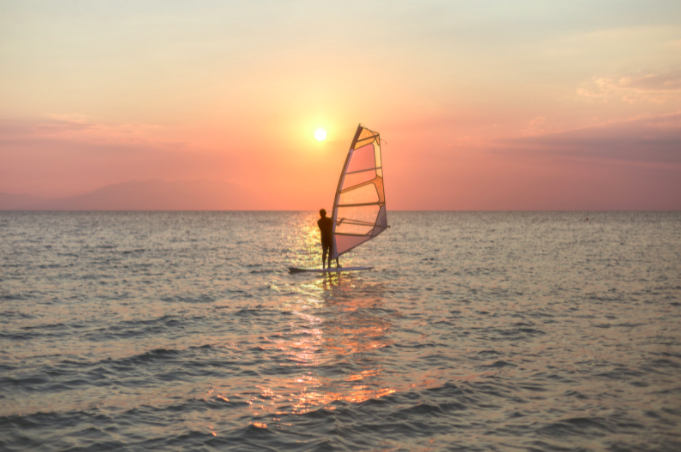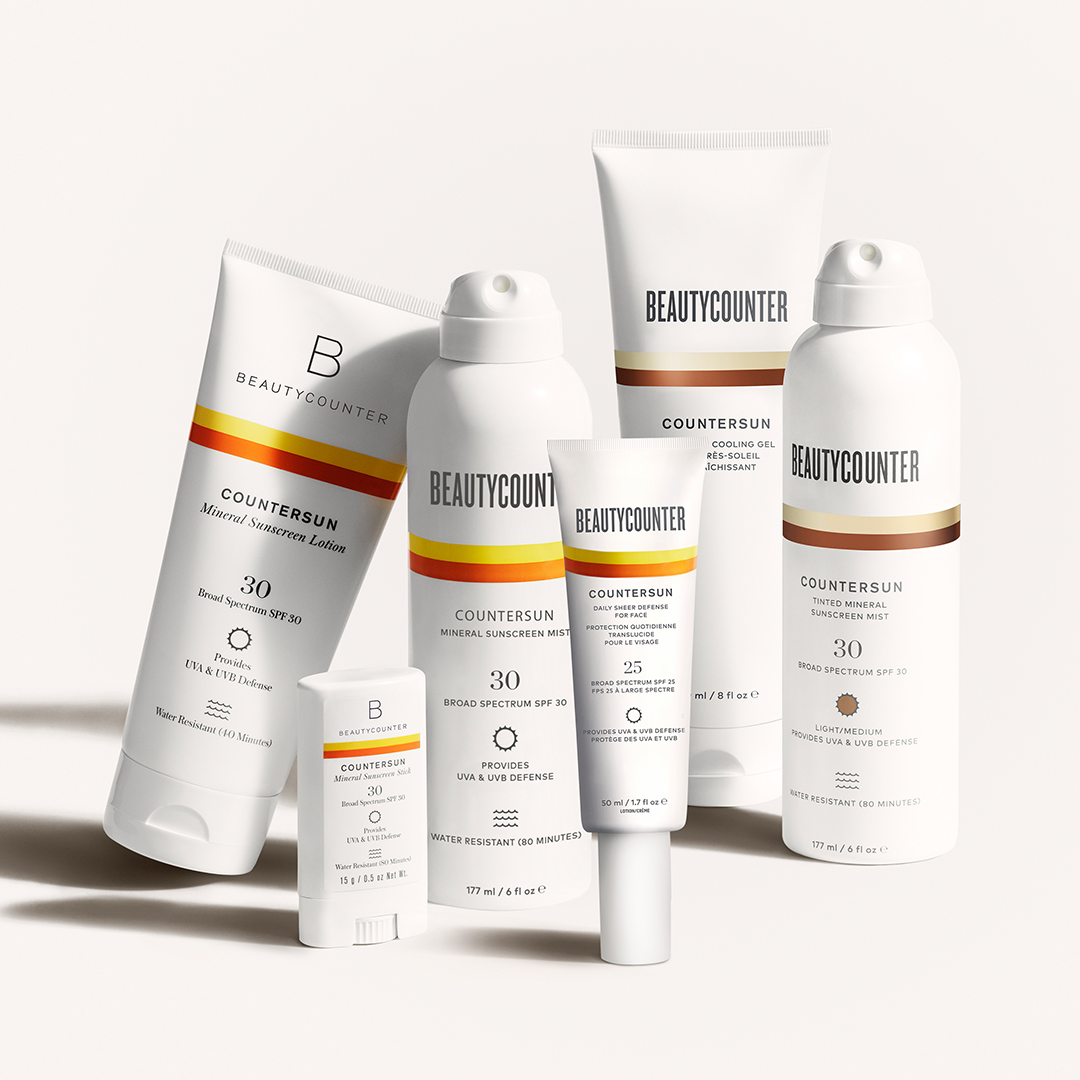Sunscreen, Windsurfing + the J & J Recall
I grew up in Reno, Nevada. Now, when most people think of Reno, they think “biggest little city in the world” and casinos. What a lot of people don’t realize is that Reno is an incredibly beautiful place with a wide array of lakes and mountains within a 30 minute drive. If you love to bike, hike, ski or in my case – windsurf – this is a wickedly fun place to grow up.
As a teenager, I spent my summers at the YMCA. They had the most incredible summer camps, and this is where I learned to windsurf and to sail. My mom and I found a windsurfer at a garage sale, and I lugged that monster from one lake to the next. To this day, there’s nothing quite like the feeling of my sail catching the wind and being carried across a wide, cool lake.
I want to get to talking about sunscreen, so I’ll make this story as short as possible.
In my windsurfing days, one of the lakes I frequented the most was Boca. It’s large and gorgeous and has a rope swing you can only access by boat – or in my case, windsurfer. It was a brisk morning in June, and me, my mom and my uncle had just arrived on the banks of Boca for a day in the water. We decided to set up camp on the opposite side of the lake than we normally do. We had no idea what a massive mistake that would be.
I was so excited to enjoy the early morning wind, that I hopped on my windsurfer for a quick tour of the lake with the intention of coming back within a few minutes to apply sunscreen and prep for the day. With only my bikini covering my ghost white skin, I ventured out. When I hit the middle of the lake I suddenly realized why no windsurfers docked on the side of the lake we had.
For those of you who are master windsurfers and sailors, what happened next will make more sense to you than to me. When I hit the middle of the lake, the wind was suddenly coming from all sides, and I couldn’t keep my sail up. Flash forward to countless hours later…I had been knocked off of my windsurfer hundreds of times.
I was terrified.
There were other windsurfers on the lake that day. They would wave to me and watch me fall over and over again, but there was nothing they could do. They wouldn’t cross into the vortex I was in. At dusk, I finally gave up, packed my windsurfer onto my board and paddled us both (the windsurfer and me) to the other side of the lake.
I can’t begin to describe the sheer exhaustion and relief I felt when I finally lied down on solid ground. And I had the world’s worst sunburn. For two weeks after this harrowing adventure, my body broke out in blisters. I was so sun burnt it was hard to sleep at night or take showers. Sun cancer runs in my family, and I can only hope that the great care I’ve taken with my skin since this event will work in my favor.
So, we’ve established that sunscreen is a necessity when you get stuck on a windsurfer in the middle of a lake.
What you may not know is that sunscreen is not just a summertime thing. It’s a daily thing.
AND if you’ve been keeping up with the news lately, sunscreen can have chemicals in it that are not only really toxic to your health but are also incredibly toxic to the bodies of water we swim in, especially coral reefs.
Read on to get the 411 on sunscreen!

Valisure Study
Valisure is an independent lab that analyzes and certifies products. At the end of May it published a study that found that 78 (out of 294) different sunscreen and after sun products contained benzene, a human carcinogen known to cause blood cancers in humans. Valisure has petitioned the FDA to recall the 78 products and to conduct its own investigation into the manufacturing of these products.
In total, 294 sun product lots were tested from 69 different brands. The following brands made sun products (sprays, lotions, gels, etc.) that have lot numbers Valisure is asking the FDA to recall: Neutrogena, Sun Bum, CVS Health, Fruit of the Earth, Raw Elements, SunBurnt, Goodsense, Banana Boat, TopCare Everyday and EltaMD.
It’s important to note that not all products made by these brands had detectable levels of benzene.
Nearly all of the 14 sunscreen products with benzene levels above 2 ppm were sprays; but the chemical also showed up in lotions and sunburn-relief gels.
“There is not a safe level of benzene that can exist in sunscreen products,” stated Dr. Christopher Bunick, MD, PhD, Associate Professor of Dermatology at Yale University. “Even benzene at 0.1 ppm in a sunscreen could expose people to excessively high nanogram amounts of benzene.”
To read about the Valisure study, click HERE.
What is Benzene?
Benzene is a colorless or light yellow liquid that forms naturally but is also produced by human activities, according to the Centers for Disease Control and Prevention (CDC). For example, automobile emissions and the burning of coal and oil can release benzene into the air; the chemical is also used in the manufacturing of some plastics, rubbers, dyes, detergents, drugs and pesticides, according to the CDC.
The FDA says that benzene should not be used in the manufacturing of drug products except in special circumstances, mainly if their use is unavoidable and the drug product makes a significant therapeutic advance. In these cases, benzene levels should be limited to 2 ppm “unless otherwise justified,” the FDA says.
Stats & Facts
According to the Skin Cancer Foundation, an estimated 90% of the signs of aging are caused by the sun, and in the U.S., more people are diagnosed with skin cancer than all other cancers combined.
Sunscreen should protect you from both UVA and UVB rays. UVA has been found to be responsible for premature aging and skin cancer, while UVB rays is considered the primary cause of sunburn and skin cancer.
Higher SPF doesn’t guarantee equally high UVA protection—in fact, the FDA recently proposed a cap of SPF 60.
Many sunscreens on the market use ingredients like oxybenzone or octinoxate, which have suspicious health and environmental impacts. There’s no need to buy this stuff because clean sunscreens really work!
Spray-on sunscreens are not always dangerous. At Beautycounter, they choose air-powered over aerosol. It’s formulated with non-nano-sized zinc oxide particles that are about 10 times larger than those that can be inhaled and potentially lodged deep in the lungs.
One of the most common skin-care misconceptions is that having extra melanin in your skin means you’re exempt from slathering on sunscreen—but the sun’s harmful ultraviolet rays aren’t discriminatory.
Sunscreen should be worn all year – UVA rays can still penetrate deep into your skin through clouds, smog, and glass (especially if you’re next to a window).
The best practice for optimal sun protection is to apply sunscreen liberally and evenly, 15 minutes before sun exposure.
According to the FDA, a proper amount of product is at least 1 oz/30 g (about the amount to fill a shot glass) of sunscreen for an average-sized adult to evenly cover the body from head to toe. As for your face? Apply about the size of a nickel to cover your entire face and neck. Reapply every 2-4 hours
Yes, sunscreen does expire.
Some sunscreens are bad for the environment, particularly our oceans. Beautycounter’s entire Countersun line is formulated without octinoxate and oxybenzone, two common sunscreen ingredients that harm coral reefs.
Skin cancer affects one in five Americans, and more people are diagnosed with skin cancer each year in the U.S. than all other cancers combined.
New Sunscreen Laws
Hawaii is the first state ever to enact legislation to ban harmful chemicals from sunscreen—octinoxate and oxybenzone. In an effort to protect Hawaii’s fragile marine ecosystem—and public health—the new law bans the sale of sunscreen that contains these two harmful ingredients.
Scientific studies have found that oxybenzone, butylparaben, octinoxate and 4MBC, have been linked to killing coral reef systems. This is problematic for a few reasons: coral reefs are dying off at alarming rates due to the rising water temperatures caused from human-induced climate change. Second, many people unknowingly wear sunscreen that rinses off their bodies while snorkeling and scuba diving around coral reefs, altering the coral DNA. (It then makes you wonder what it’s doing to us…)
Florida and California are currently debating enacting similar laws.
Shopping for Safe Sunscreen
The same ingredients that are being banned to protect coral reefs have also have been linked to some bad health impacts for humans. Oxybenzone is a hormone-disrupting chemical that has been linked to altering sperm in men and endometriosis in women. Parabens have been widely found in human breast tissue and are suspected to be hormone disrupting chemicals as well.
To find “reef safe” sunscreens, avoid these ingredients:
- oxybenzone
- butylparaben
- octinoxate
- 4MBC
- vitamin A and retinol ingredients
The Environmental Working Group (EWG) released their 11th annual Sun Safety Report, which gives an in-depth review of the ingredients in sunscreen as well as recommendations for the safest brands to buy. Some of my favorite brands made the cut.
My Favorite Beautycounter Sunscreens
Both the Environmental Working Group as well as Hawaii approve of all of Beautycounter’s sunscreens. Here are my favorites:
Countersun Mineral Sunscreen: I use this sunscreen for my body and my neck and decollote. As a general rule, I’ll moisturize first, and then apply this to any area of my body I know won’t be covered by clothing. Sometimes, if I’m not using the Dew Skin Tinted Moisturizer, I’ll also use this on my face. Bonus: it doesn’t leave the greasy, white residue so often found in other natural sunscreens. SPF 30 and water-resistant for 40 minutes.
Countersun Mineral Stick : I keep this sunscreen in my car to reapply to my hands, arms and decollete. It goes on smooth, and doesn’t require a lot of time to rub in and to dry. SPF 30 and water-resistant for 80 minutes.
Countersun Mist: I use this sunscreen on my daughter who is not patient enough to wait for me to rub the Countersun Mineral Sunscreen on. Who could blame her? The pool is calling! SPF 30 & water-resistant for 80 minutes.
Dew Skin Tinted Moisturizer: This is a pillar of my morning routine. This moisturizer is slightly tinted, so when I don’t want to mess with an involved beauty care regimen, I’ll throw this on with some mascara and blush, and I’m set. SPF 20 + glow-boosting ingredients of a triple complex of black currant seed oil, peony root extract, and vitamin C for increased appearance of firmness and radiance over time.
I am a Beautycounter consultant, and I would sure love your business. If you click on the links above you’ll be taken to my personal Beautycounter website. But, keep in mind that Beautycounter isn’t the only the name in the game of clean personal care products, and that the EWG is a great resource for researching your personal care product purchases.

Make Application Easy
Many of us discontinue the use of daily sunscreen in the fall months and that can be problematic because even when the sun is hiding behind a cloud or a window, it can still harm your skin. Here’s a simple fix to applying sunscreen on the run: Keep this Protect Stick Sunscreen in your car or by your door and quickly apply a layer when you go out.
Keep in mind that your hands, neck and decollete bear the brunt of sun exposure, especially in the winter months when we aren’t as diligent about sunscreen application.
You’ll be happy to find that despite being a mineral-based sunscreen, it glides on easy and doesn’t leave a white sticky residue.
About me

For the last twenty years, I have helped people take charge of their health and feel better. I have been in your shoes - sick, tired, and overwhelmed by how to actionably care for myself. If you want to feel better, but don't know where to start, you've come to the right place. Learn More >
Subscribe
Sign up for my monthly newsletter for health and wellness tips!
4 Comments
Hi Ishbel
I enjoyed this latest Blog. As a long time windsurfer I could relate to your story-both from “being terrified” by the sport (which inevitably happens) and the extreme sun exposure. Thanks for sharing your experience.
With the recent findings published about sun care products I’m ready to make a change in the products I choose to use not only for the personal health concerns but for the environment. I plan to give Beautycounter products a try!
Hi Patty, It is such a joy to hear from you. Thank you for relating to the terror. Wow! Windsurfing is an incredibly sport, and I had a whole new respect for it and the water after that day. I’m so happy to hear you’re going to make the switch for the environment and for your own health. Keep in mind I offer a complimentary 30 minute consult to discuss clean personal care products. Everyone’s needs are different, and I’d be so happy to help you figure out what products would be the best fit for you.
I’m in! Just scheduled some time with you to discuss making some changes! Looking forward to it!
Yay! I’m so glad. Looking forward to it!